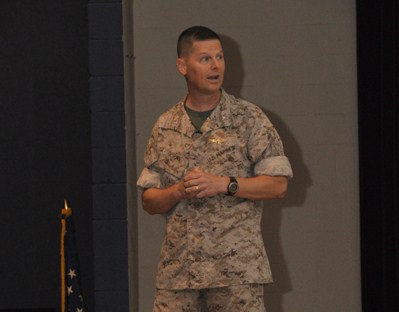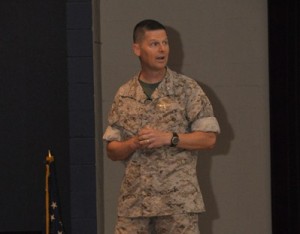Marines Recount Libya Ops


Col. Mark Desens, 26th Marine Expeditionary Unit commanding officer, debriefed employees July 26 at NAVAIR's fourth Meet the Fleet event. (US Navy photo)
By NAVAIR Headquarters
The 26th Marine Expeditionary Unit’s (MEU) recent deployment gives new meaning to the term “rapid response.”
Marines from the 26th MEU, with Amphibious Squadron (PHIBRON) 4 Amphibious Ready Group (ARG), were the first on station with the full range of capabilities used for Operation Odyssey Dawn, and provided the most responsive and capable force for recovery of the downed Air Force F-15E pilot in Libya, said Col. Mark J. Desens, commanding officer of the 26th MEU, during the fourth Meet the Fleet event sponsored by Naval Air Systems Command.
This ability to rapidly respond comes from the forward deployment of the Navy/Marine Corps team aboard aircraft carriers, or in the MEU’s case, big deck amphibious ships such as USS Kearsarge (LHD 3), USS Carter Hall (LSD 50) and USS Ponce (LPD 15) of PHIBRON-4 ARG, Desens said.
Desens recounted the MEU’s nine-month deployment to about 300 NAVAIR employees July 26 as part of NAVAIR Commander Vice Adm. David Architzel’s initiative to strengthen the command’s connection to the warfighter.
Rear Adm. Donald Gaddis, program executive officer for Tactical Aircraft Programs, welcomed the MEU and echoed the value of expanding the fleet debriefs to the workforce. Gaddis experienced deployment debriefs when he served as the PMA-265 F/A-18 and EA 18G program manager.
“Those debriefs had a direct impact on those of us who were responsible for the care and feeding of those aircraft,” Gaddis said. “We always learned something. The fact that we’re bringing it across the organization is a fantastic idea.”
The fleet connection works both ways. Before Desens and his men left Naval Air Station Patuxent River, one of the MEU’s supply issues was resolved. Capt. Paul Overstreet, PMA-272 Advanced Tactical Aircraft Protection Systems program manager, made the necessary connections to ensure amphibious carriers have expendable flares, named MJU-55, available for deployed Harriers. The flare is used to defeat infrared missile threats.
Desens thanked NAVAIR employees for all they did, praising the CH-53 and the AV-8B aircraft, saying “the Echo [CH-53E] was awesome, and the CH-53K will be better. The aircraft performed magnificently, both Navy and Marine Corps. All of you that keep that aircraft healthy, thanks a lot. You did good,” Desens said.
Executing the maritime strategy
The MEU’s deployment covered the full spectrum of maritime strategy missions, Desens said, and they covered that range while disaggregated or disbursed.
On one end of the spectrum, the MEU conducted a humanitarian assistance and disaster response mission in Pakistan, participated in Theater Security Cooperation by training coalition partner forces in Jordan, and helped rebuild a school in Kenya. On the other end, the MEU saw combat in Afghanistan, where the Marines took a sanctuary away from the Taliban, and enabled the Afghan government to build a major roadway.
“That’s the operational flexibility you get by having Sailors and Marines on ships forward deployed,” Desens said. “You get to have that presence and that flexibility.”
That flexibility was demonstrated as the MEU reassembled or aggregated in Kuwait, with Kearsarge 100 miles off of Benghazi, Libya. Kearsarge’s location enabled the Marines to respond to the crisis in Libya, buying leadership decision time, Desens said.
“The Kearsarge was far closer to Libya than the joint air bases used by jets from other allied countries,” Desens said. “This enabled the Harriers to fly not one but two sorties per night.” The Harriers were also able to take out mobile targets because the aircraft were only 15 minutes away which meant the intelligence information remained current.
This proximity and the uncertain environment surrounding the downed F-15E led to the MEU’s selection to conduct the Tactical Recovery of Aircraft Personnel or TRAP mission, Desens said. Part of that uncertainty included knowing who the oppositions was as well as the exact location of the pilot and why the airplane fell out of the sky, he said, setting the scene for the account by MV-22 Osprey pilot Marine Capt. Joe Andrejack, Weapons and Tactics Instructor.
“If you call us and want an American out, we are going to do whatever it takes,” Andrejack said before describing the fast-paced events leading to the F-15E pilot’s rescue.
They received the launch order two hours after receiving word that the pilot was down, he said. It took 45-50 minutes to fly the 150 nautical miles. Five miles away from the pilot’s location, Andrejack saw the pilot’s flare. The other Osprey pilot did not see the flare so Andrejack told his section lead he had him.
“We landed about 50 yards in front of the pilot,” Andrejack said. “He was on the back of my aircraft before all of my Marines got off. We ended up spending a total of 90 seconds on deck, and that time was spent rounding up all the Marines that went out.”
“The big takeaway is the speed in which we were able to execute this mission,” Andrejack said. “Our average speed was 260-270 knots, twice as fast as any helicopter. We had [the Air Force pilot] off Libyan soil at least one hour earlier than a CH-53 or an H-60.”
Desens had nothing but praise for the MV-22, which he said had a landmark deployment, whether flying a 500-mile logistics leg or rescuing the downed pilot.
Desens also took the opportunity to advocate for the importance of the Joint Strike Fighter Marine variant, the F-35B.
“For those that work the F-35B, this is the best open source example,” Desens said. “Because of the demand for the aircraft carriers that can’t be everywhere, we need STOVL [short take off and vertical landing] strike aviation and big deck amphibs.”






















